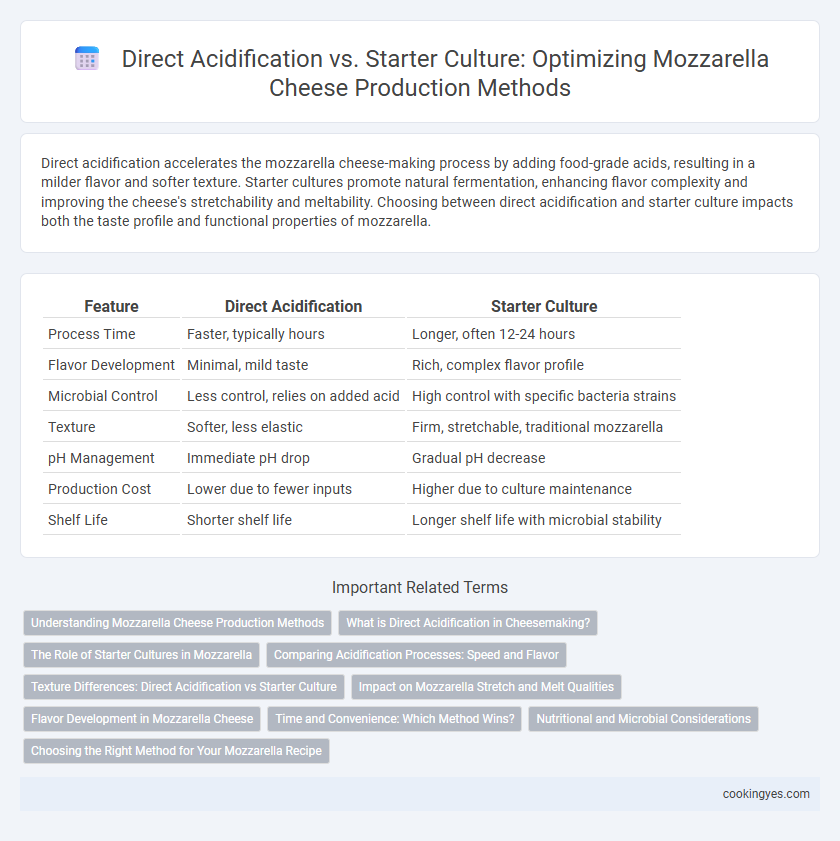Direct acidification accelerates the mozzarella cheese-making process by adding food-grade acids, resulting in a milder flavor and softer texture. Starter cultures promote natural fermentation, enhancing flavor complexity and improving the cheese's stretchability and meltability. Choosing between direct acidification and starter culture impacts both the taste profile and functional properties of mozzarella.
Table of Comparison
| Feature | Direct Acidification | Starter Culture |
|---|---|---|
| Process Time | Faster, typically hours | Longer, often 12-24 hours |
| Flavor Development | Minimal, mild taste | Rich, complex flavor profile |
| Microbial Control | Less control, relies on added acid | High control with specific bacteria strains |
| Texture | Softer, less elastic | Firm, stretchable, traditional mozzarella |
| pH Management | Immediate pH drop | Gradual pH decrease |
| Production Cost | Lower due to fewer inputs | Higher due to culture maintenance |
| Shelf Life | Shorter shelf life | Longer shelf life with microbial stability |
Understanding Mozzarella Cheese Production Methods
Direct acidification and starter culture methods both play critical roles in mozzarella cheese production, impacting flavor development, texture, and fermentation time. Direct acidification uses food-grade acids to lower pH rapidly, resulting in a mild-tasting cheese with a firmer texture and faster production, while starter cultures rely on lactic acid bacteria to ferment lactose, developing complex flavors and a stretchable, elastic texture synonymous with traditional mozzarella. Producers select the method based on desired taste profiles, production speed, and equipment capabilities, balancing efficiency with artisanal qualities.
What is Direct Acidification in Cheesemaking?
Direct acidification in cheesemaking involves adding food-grade acids such as citric or lactic acid directly to milk to rapidly lower its pH, bypassing the need for bacterial fermentation. This method accelerates the curdling process, resulting in a faster production time for mozzarella cheese compared to starter culture fermentation. Direct acidification also provides consistent acid levels, impacting moisture retention and texture in the final cheese product.
The Role of Starter Cultures in Mozzarella
Starter cultures play a crucial role in mozzarella production by initiating controlled fermentation that enhances flavor, texture, and shelf life. These cultures release lactic acid, lowering pH gradually to achieve optimal curd formation and moisture retention, unlike direct acidification which rapidly changes acidity but lacks depth in flavor development. The microbial activity in starter cultures also contributes beneficial compounds and influences the cheese's stretchability and melt characteristics.
Comparing Acidification Processes: Speed and Flavor
Direct acidification accelerates mozzarella production by rapidly lowering pH through added acids, resulting in a faster coagulation process compared to the gradual acid development by starter cultures. Starter cultures contribute complex, nuanced flavors due to the extended fermentation time allowing diverse microbial activity, whereas direct acidification often yields a milder, more neutral taste. The choice between methods impacts both production efficiency and the characteristic flavor profile of the final mozzarella cheese.
Texture Differences: Direct Acidification vs Starter Culture
Direct acidification in mozzarella production results in a firmer, less elastic texture due to rapid pH drop, which limits protein breakdown and moisture retention. Starter culture fermentation promotes a slower acid development, enhancing texture by allowing better curd formation and more elastic, stretchable cheese. The controlled acidification from starter cultures delivers a tender, springy mouthfeel preferred in traditional mozzarella.
Impact on Mozzarella Stretch and Melt Qualities
Direct acidification produces a faster acid development in mozzarella, resulting in a firmer curd with less elasticity, which reduces stretchability and creates a denser melt. Starter culture fermentation promotes a gradual acidification, leading to a more balanced pH that enhances curd structure, producing mozzarella with superior stretch and smooth, creamy melt qualities. The choice between direct acidification and starter cultures significantly affects mozzarella's functional properties critical for pizza topping applications.
Flavor Development in Mozzarella Cheese
Direct acidification in mozzarella cheese production leads to a faster pH drop, resulting in a milder and less complex flavor profile due to limited microbial activity. Starter cultures contribute to flavor development by fermenting lactose into lactic acid and producing flavor compounds such as diacetyl and acetaldehyde, which enhance the cheese's aromatic complexity. The choice between direct acidification and starter cultures significantly impacts the sensory attributes, with starter cultures generally providing a richer and more nuanced flavor in mozzarella.
Time and Convenience: Which Method Wins?
Direct acidification accelerates mozzarella production by rapidly lowering pH levels within hours, significantly reducing overall fermentation time compared to traditional starter culture methods. Starter cultures, although slower due to their reliance on bacterial growth and acid production over 12 to 24 hours, enhance flavor complexity and texture development. For time and convenience, direct acidification is the preferred choice in industrial settings requiring swift cheese turnover.
Nutritional and Microbial Considerations
Direct acidification in mozzarella production offers precise control over pH levels, resulting in consistent texture and reduced microbial activity, which minimizes spoilage but limits probiotic benefits. Starter cultures introduce beneficial lactic acid bacteria, enhancing microbial diversity and potentially improving gut health while contributing to flavor complexity and natural acidification. Nutritionally, starter culture mozzarella may have increased bioactive compounds and vitamins due to bacterial fermentation, whereas direct acidification primarily focuses on rapid acid adjustment without these additional health benefits.
Choosing the Right Method for Your Mozzarella Recipe
Direct acidification offers faster production by adding food-grade acids to milk, resulting in a tangier flavor and firmer mozzarella texture. Starter cultures promote natural fermentation, enhancing complex flavor profiles and improving cheese meltability through lactic acid bacteria activity. Selecting the optimal method depends on desired flavor intensity, production speed, and cheese texture characteristics.
Direct Acidification vs Starter Culture for Mozzarella Infographic

 cookingyes.com
cookingyes.com